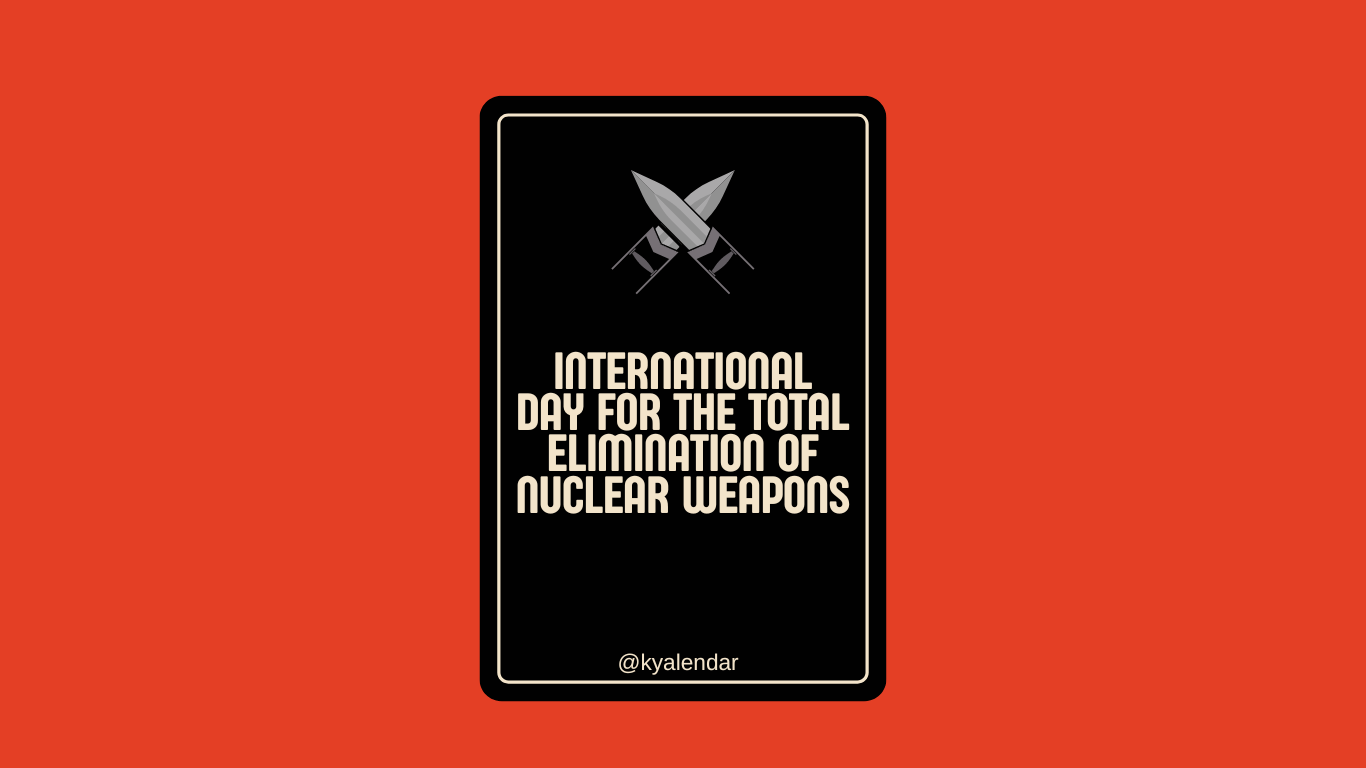
- This event has passed.
International Day for the Total Elimination of Nuclear Weapons
September 26

The International Day for the Total Elimination of Nuclear Weapons is observed annually on 26th September. This day serves as a global platform to advocate for the eradication of nuclear weapons, highlighting the ongoing risks posed by these arms and the urgent need for comprehensive disarmament.
Historical Context and Significance
The International Day for the Total Elimination of Nuclear Weapons was established by the United Nations General Assembly in 2013. The observance underscores the persistent global threat posed by nuclear weapons and the collective aspiration to achieve a world free from their destructive potential. The day aligns with broader disarmament efforts and reinforces the international community’s commitment to ensuring that nuclear weapons do not endanger future generations.
The history of nuclear weapons is marked by profound events that have shaped global politics and security. The atomic bombings of Hiroshima and Nagasaki in 1945 demonstrated the catastrophic impact of these weapons, leading to the Cold War arms race and the proliferation of nuclear arsenals. Despite numerous treaties and agreements aimed at controlling and reducing nuclear weapons, the presence of these arms remains a significant concern for global security.
Objectives and Activities
The primary objective of the International Day for the Total Elimination of Nuclear Weapons is to galvanise support for disarmament and raise awareness about the ongoing threats posed by nuclear weapons. Activities on this day include educational campaigns, public discussions, and advocacy efforts designed to foster a broader understanding of nuclear disarmament issues.
Educational initiatives often focus on informing the public about the humanitarian consequences of nuclear weapons, including their potential for mass destruction and long-term environmental impact. These initiatives may include lectures, workshops, and exhibitions that highlight the need for urgent action to prevent the further proliferation of these arms.
Public discussions and events on this day aim to engage a wide audience, including policymakers, academics, and civil society organisations. These discussions provide a platform for sharing insights, proposing solutions, and building consensus on the path towards total disarmament. The engagement of diverse stakeholders helps to reinforce the message that nuclear disarmament is a shared responsibility and a critical goal for international security.
Advocacy efforts often involve lobbying governments and international organisations to strengthen existing treaties and agreements related to nuclear disarmament. These efforts also focus on promoting new initiatives that address emerging challenges in the field of nuclear weapons, such as the potential for nuclear proliferation or the development of new technologies that could impact disarmament efforts.
Key Treaties and Agreements
Several key treaties and agreements have shaped the global landscape of nuclear disarmament and non-proliferation. These include:
- The Treaty on the Non-Proliferation of Nuclear Weapons (NPT): Opened for signature in 1968, the NPT is a cornerstone of the global non-proliferation regime. It aims to prevent the spread of nuclear weapons, promote peaceful uses of nuclear energy, and advance efforts towards nuclear disarmament.
- The Comprehensive Nuclear-Test-Ban Treaty (CTBT): Adopted in 1996, the CTBT seeks to ban all nuclear explosions for both civilian and military purposes. While it has not yet entered into force, it represents a significant step towards reducing the risk of nuclear testing and proliferation.
- The Treaty on the Prohibition of Nuclear Weapons (TPNW): Opened for signature in 2017, the TPNW is a legally binding international agreement that prohibits the use, development, production, and possession of nuclear weapons. It represents a landmark achievement in the pursuit of total disarmament and reflects the growing global consensus on the need to eliminate nuclear weapons.
Challenges and Future Prospects
Despite the progress made in the field of nuclear disarmament, significant challenges remain. These include the persistence of existing nuclear arsenals, the risk of new states acquiring nuclear weapons, and the potential for emerging technologies to impact disarmament efforts.
Addressing these challenges requires continued international cooperation and commitment. The International Day for the Total Elimination of Nuclear Weapons serves as a reminder of the importance of maintaining momentum in disarmament efforts and reinforcing the global resolve to achieve a world free from nuclear weapons.
The day also provides an opportunity to reflect on the humanitarian impact of nuclear weapons and to advocate for policies and practices that promote peace and security. By fostering dialogue, raising awareness, and supporting disarmament initiatives, the observance contributes to the broader goal of creating a safer and more secure world for future generations.
Conclusion
The International Day for the Total Elimination of Nuclear Weapons is a vital occasion for raising awareness about the dangers of nuclear arms and advocating for their complete eradication. As the global community reflects on the need for disarmament, this day underscores the collective responsibility to address the risks associated with nuclear weapons and to work towards a future free from their devastating potential.
Through education, advocacy, and international cooperation, the observance of this day helps to reinforce the commitment to nuclear disarmament and to promote efforts that contribute to global peace and security. As we mark the International Day for the Total Elimination of Nuclear Weapons, we are reminded of the enduring importance of working towards a world where the threat of nuclear conflict is eliminated and where future generations can live without the shadow of nuclear weapons.
Details
- Date:
- September 26